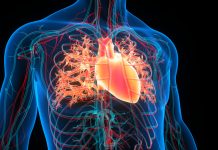Dr Campbell Rogers, Chief Medical Officer at HeartFlow, examines how the healthcare industry can best prepare to combat heart disease in a post-pandemic environment
Recent studies have found public health has taken a significant dive in 2021, with extended lockdowns and increased restrictions contributing to worsening habits around eating and exercise. For example, two-fifths of people said that they were exercising less during January 2021’s lockdown than they were during the lockdown of Spring 2020. This has been compounded by a shift in the public’s diet, with 90% of British households increasing their calorie intake during the pandemic – largely attributed to a heavier reliance on takeaways and bigger supermarket shops.
Such factors, combined with backlogs in diagnostic healthcare and strains on the health service can have significant impacts on those living with heart disease. In fact, The British Heart Foundation has predicted that there will be a rise in the UK’s heart disease death rate this year, up from 2020’s numbers.
As we begin to emerge from the pandemic, it is vital that attention is turned towards diagnosing and treating heart disease as efficiently as possible to improve outcomes for patients. To do that, I believe we need to build a greater understanding of heart disease among the public whilst harnessing the capabilities of cutting-edge technologies that will allow clinicians to streamline services and identify those most in need of intervention.
Increasing consumer knowledge of heart disease
The healthcare system alone cannot tackle the rise in heart disease. Coronary Heart Disease (CHD) remains one of the UK’s biggest killers, responsible for over 64,000 deaths annually. While prevention should always be the goal with heart health, when cases do arise, time is absolutely of the essence when it comes to treatment.
It is essential that members of the public are well-versed on the signs and symptoms of heart disease. Many may be familiar with chest pain or tightness as two of the chief symptoms of the condition, but how many know that breathlessness is a symptom, particularly when at rest or doing low impact activities?
Women’s symptoms can vary even further, with nausea, jaw or back pain often being overlooked as something unrelated to the heart. We need to encourage people to seek medical advice when experiencing these things and, what’s more, it is hugely important that GPs and other healthcare professionals recognise the warning signs too.
After all, experiences of heart disease and heart attacks are often far from the depictions of men clutching their chest and dramatically dropping to the floor that we see so frequently on TV.
There is a wealth of support out there and a population that is more comfortable than ever in using technology to access it. Remote health services such as via the NHS App, NHS login and NHS pathways saw a surge in patient uptake during the pandemic. Encouraging people to continue to use these resources for day-to-day health advice could encourage people to report heart disease symptoms sooner and with more confidence, helping to unlock diagnosis and treatment faster.
Technology helping to advance patient healthcare
While it does not hold all the answers, there is an opportunity for technology to help provide the public with consistent access to cardiac care, as well as ease the pressure on resources and help hospitals manage their waiting lists more effectively.
The NHS continues to provide an exceptional service, but it faces a couple of significant challenges as a result of the COVID-19 pandemic. The first is a backlog in elective procedures and health screening. The second is varying levels of access to the best services between the richest and poorest areas in the UK.
When it comes to heart health, the NHS is working hard to address these challenges and recently published the Get it Right First Time report examining the varying levels of access to cardiology services across hospitals in England. Using technology to provide the best possible outcomes was a core recommendation of this report.
It suggested that all Trusts within the NHS England network should adopt fractional flow reserve derived from CT – or FFRct – when diagnosing CHD, and that this technology should be deployed across the board within a year of the report’s publication.
FFRct technology supports a CT-first, non-invasive approach to CHD diagnosis. The NHS is already a world-leader in deploying this method, which takes data from a CT scan and leverages deep learning to create a personalised, digital 3D model of a patient’s arteries. Algorithms then solve millions of equations to simulate how blood is flowing through the arteries, which allows clinicians to understand the impact of any blockages.
Non-invasive technologies such as FFRct can negate the need for more invasive investigations such as angiograms, which can carry risks of complication. It also allows doctors to assess the severity of disease with greater accuracy, meaning patients get quick and more tailored treatment plans, and interventions like stenting or bypass surgery are prioritised for those who need it most.
Such technology is also invaluable during times of disruption for the health service, which may be dealing with backlogs or extended waiting times.
Dr Vin Majuran, Consultant Radiologist at Kingston Hospital has been using CT scanning with FFRct technology throughout the pandemic. According to him, having anatomical and functional information in one place, provides confidence in decision-making:
“Using FFRct means we can confidently say whether a patient requires further investigation in the catheterisation lab or if they can be treated with medication alone. The technology has played a critical role in the pandemic and prevented beds being used for patients that don’t require treatment.”
FFRct is just one of the technologies included in the NHS’ new MedTech Funding Mandate, which seeks to accelerate the uptake of innovation capable of improving patient outcomes and reducing costs. Bold steps such as these are crucial in allowing the health service to remain a world-leading care provider and the technologies they promote can help keep the wheels turning, even in times of huge demand.
Forging a path in uncertain territory
Heart health remains one of our most critical healthcare priorities. Not only can poor heart health devastate lives, but it can lead to huge resource and cost requirements from health services.
Giving people the tools to help prevent heart disease and reduce their risk factors will be absolutely essential to improving outcomes in the long-term. Part of this comes down to education and the importance of building public understanding around the lifestyle choices that can improve their health. But it also relies on frontline healthcare services to be attuned to the nuances of heart disease and recognise the warning signs when they appear.
Beyond this, investing in technology that facilitates a fast and accurate diagnosis is vital. Relatively speaking, we’re standing at the starting line of AI and technology’s involvement in healthcare, but its potential is huge. Technology already enables patients to access support and medical consultation from anywhere, and is playing an important role to streamline the diagnostic process and improve treatment efficacy. Taking steps to embrace new technologies and putting in place the systems that allow health services to quickly onboard them will ultimately save countless lives, reduce costs and streamline the delivery of care.








